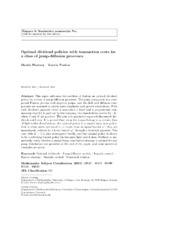Optimal dividend policies with transaction costs for a class of jump-diffusion processes
Peer reviewed, Journal article
Accepted version
Permanent lenke
https://hdl.handle.net/1956/6214Utgivelsesdato
2012Metadata
Vis full innførselSamlinger
Originalversjon
https://doi.org/10.1007/s00780-012-0186-zSammendrag
This paper addresses the problem of finding an optimal dividend policy for a class of jump-diffusion processes. The jump component is a compound Poisson process with negative jumps, and the drift and diffusion components are assumed to satisfy some regularity and growth restrictions. Each dividend payment is changed by a fixed and a proportional cost, meaning that if ξ is paid out by the company, the shareholders receive kξ−K, where k and K are positive. The aim is to maximize expected discounted dividends until ruin. It is proved that when the jumps belong to a certain class of light-tailed distributions, the optimal policy is a simple lump sum policy, that is, when assets are equal to or larger than an upper barrier uˉ∗ , they are immediately reduced to a lower barrier u−∗ through a dividend payment. The case with K=0 is also investigated briefly, and the optimal policy is shown to be a reflecting barrier policy for the same light-tailed class. Methods to numerically verify whether a simple lump sum barrier strategy is optimal for any jump distribution are provided at the end of the paper, and some numerical examples are given.
